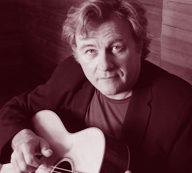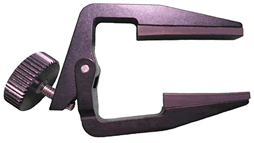|
 Welcome
from your host Harvey Reid... Welcome
from your host Harvey Reid...
About me.. I have been using various kinds of partial capos for both
songs and instrumentals in my music since the mid 1970's, and I am probably the first modern person to write,
publish and record music for the partially-capoed guitar. I won the National Fingerpicking Guitar Contest in
1981 (without using one) and have recorded about 200 different songs and instrumentals in dozens of different capo configurations. I have studied this idea very deeply, and I want to be your guide to this fascinating musical world. I hope to show
you what they can do for your music. There is a surprising amount of misinformation and confusion about partial capos, and many a great guitarist has failed to see their musical value right away.
See the rave review of Harvey's "Liberty Guitar Album" in Premier Guitar
I have been working for over 7 years on a very ambitious series of books that
explain carefully hundreds of ways to use the various types of partial capos, and I have very exciting news and discoveries I'd like to share...10 Capo Voodoo books are now done! They are the best source of information on earth about partial capos, and are available
in our store and world-wide from AMAZON. Two Capo Voodoo CD's are also available on iTunes and other download services, and as physical CD's. Please
look around this web site and see what you can find. What seems to be a harmless guitar gadget is actually
a surprisingly deep subject that can keep you busy for decades and provide you with a wealth of new music with the skills you already have.
Here at PartialCapo.com...
- I have been selling and explaining over 50 kinds of capos for a number of years while I have been researching, and have now developed what I think is the ultimate partial capo. The Liberty FLIP capo can do almost all of the important partial capo ideas, do them better, and it is less visible than other common types of partial capos. It fits more guitars and is musically more versatile. It's the only capo I now take to my gigs, and it's the one I think you should have in your guitar case.
- After manufacturing and selling Third Hand capos for over 30 years, I have decided to stop, and focus my time and energy on Liberty capos, that I think are fundamentally more useful. The Third Hand capo was essentially an experiment, and it even looks like one. Now with the results in, it's time for the next generation of capos.

 A
partial capo creates open-string effects, new resonances, and new chord voicings similar to those achieved by non-standard tunings of the guitar. Changing
the length of an open string with a partial capo yields a similar kind of musical result as from retuning.
It is, however, fundamentally different than retuning the guitar, and you usually can't play the same music
both ways. Since most players stay in standard tuning when using a partial capo, the geometry of the scales
and chords on your fingerboard remains familiar. This is the primary advantage of using a partial capo. You
get more sound from the skills you already have. A
partial capo creates open-string effects, new resonances, and new chord voicings similar to those achieved by non-standard tunings of the guitar. Changing
the length of an open string with a partial capo yields a similar kind of musical result as from retuning.
It is, however, fundamentally different than retuning the guitar, and you usually can't play the same music
both ways. Since most players stay in standard tuning when using a partial capo, the geometry of the scales
and chords on your fingerboard remains familiar. This is the primary advantage of using a partial capo. You
get more sound from the skills you already have.
 You can
play many things just as you would in standard tuning, but also achieve the kinds of sounds we associate with an open tuning. You can
play many things just as you would in standard tuning, but also achieve the kinds of sounds we associate with an open tuning.
 Partial capos are equally valuable to a total beginner, a recreational player, songwriter, or to a serious guitarist or composer. They allow drone-string resonances and chord voicings that are very useful and desirable, and open up a new world of guitar sounds to be explored by both serious guitarists and people who just accompany songs with their guitar. There are thousands of chord voicings suddenly available that no one has ever played before. Partial capos are equally valuable to a total beginner, a recreational player, songwriter, or to a serious guitarist or composer. They allow drone-string resonances and chord voicings that are very useful and desirable, and open up a new world of guitar sounds to be explored by both serious guitarists and people who just accompany songs with their guitar. There are thousands of chord voicings suddenly available that no one has ever played before.
 There are
extremely interesting and very useful ways to use a partial capo and an altered tuning simultaneously.
Even if you are experienced with tunings, the place to begin understanding the surprisingly confusing world
of partial capos is to think of it as a "parallel universe" to the world of altered tunings. There
are over 11 million ways to partially capo a guitar in each different tuning! Only a few of them have real
musical value, but it's a vast world to explore. I have done a lot of that work for you, and have decided to publish a series of books to map out this new musical terrain. In 30 years, tens of thousands of guitarists have largely failed to find a lot of the really interesting ideas, and I want to spark some new excitement and creativity from the guitar world. I am making books because it's too much information for a web video or a phone. I have made a number of iBooks that can be found on the iTunes bookstore. There are
extremely interesting and very useful ways to use a partial capo and an altered tuning simultaneously.
Even if you are experienced with tunings, the place to begin understanding the surprisingly confusing world
of partial capos is to think of it as a "parallel universe" to the world of altered tunings. There
are over 11 million ways to partially capo a guitar in each different tuning! Only a few of them have real
musical value, but it's a vast world to explore. I have done a lot of that work for you, and have decided to publish a series of books to map out this new musical terrain. In 30 years, tens of thousands of guitarists have largely failed to find a lot of the really interesting ideas, and I want to spark some new excitement and creativity from the guitar world. I am making books because it's too much information for a web video or a phone. I have made a number of iBooks that can be found on the iTunes bookstore.
 If you
are the kind of player who has found uses for altered or open tunings, then it is almost certain that you
can find uses for a partial capo. If you
are the kind of player who has found uses for altered or open tunings, then it is almost certain that you
can find uses for a partial capo.
 A
partial capo allows you to play good-sounding things on your guitar that are not possible any other way A
partial capo allows you to play good-sounding things on your guitar that are not possible any other way
 It
is also an extremely useful tool for teaching guitar, and allows young
children and those with learning disabilities to have a very successful guitar experience. I have recenty made a game-changing discovery in the world of simplified guitar that I call Liberty Tuning. It
is also an extremely useful tool for teaching guitar, and allows young
children and those with learning disabilities to have a very successful guitar experience. I have recenty made a game-changing discovery in the world of simplified guitar that I call Liberty Tuning.
See a more detailed explanation of how a partial capo differs
from altered tunings...
I have worked for almost 40 years exploring the possibilities of the partially
capo-ed guitar, and I have only become more convinced that it is an idea of tremendous importance, and one
that will eventually become universal. There are many useful ways to partially capo a guitar, and there are
often many different uses for particular configurations. The same Esus configuration that makes guitar very
easy for beginners is also the one most widely used for composing and arranging by some of the world's most
accomplished guitarists.
|

